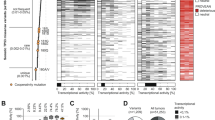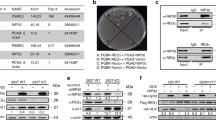Abstract
To investigate whether dysregulation of p53 phosphorylation confers tumor resistance to p53, we analysed the effects of wild-type p53 on oral squamous cell carcinoma (SCC) cell lines carrying various mutations of p53. Introduction of exogenous p53 neither induced apoptosis nor suppressed colony formation in HSC-3 cells lacking any detectable p53 and HSC-4 cells expressing mutant p53R248Q protein. Consistently, exogenous p53 did not induce proapoptotic p53-target genes in these p53-resistant cells. We found that phosphorylation of exogenous p53 on serine 46 (Ser46) was severely impaired in HSC-3 but not HSC-4 cells. A mutant mimicking Ser46-phosphorylation (p53S46D) enhanced proapoptotic Noxa promoter activity, and overcame the resistance to p53-mediated apoptosis and growth suppression in HSC-3 cells. Conversely, a mutant defective for Ser46-phosphorylation (p53S46A) failed to suppress the growth of p53-sensitive HSC-2 cells. In contrast to HSC-3 cells, p53S46D had no effect on HSC-4 cells, and inhibition of endogenous p53R248Q by siRNA restored p53-mediated apoptosis in HSC-4 cells, indicating a dominant-negative effect of p53R248Q protein on wild-type p53 function. These results demonstrate that the defect in Ser46 phosphorylation accounts for the p53 resistance of HSC-3 cells, and provide evidence for a mechanism underlying the acquisition of p53 resistance in oral SCC.
This is a preview of subscription content, access via your institution
Access options
Subscribe to this journal
Receive 50 print issues and online access
$259.00 per year
only $5.18 per issue
Buy this article
- Purchase on Springer Link
- Instant access to full article PDF
Prices may be subject to local taxes which are calculated during checkout






Similar content being viewed by others
References
Appella E, Anderson CW . (2001). Eur J Biochem 268: 2764–2772.
Ashcroft M, Kubbutat MH, Vousden KH . (1999). Mol Cell Biol 19: 1751–1758.
Bean LJ, Stark GR . (2001). Oncogene 20: 1076–1084.
Bergamaschi D, Gasco M, Hiller L, Sullivan A, Syed N, Trigiante G et al. (2003). Cancer Cell 3: 387–402.
Bode AM, Dong Z . (2004). Nat Rev Cancer 4: 793–805.
Bulavin DV, Saito S, Hollander MC, Sakaguchi K, Anderson CW, Appella E et al. (1999). EMBO J 18: 6845–6854.
Chiarugi A, Moskowitz MA . (2002). Science 297: 200–201.
D'Orazi G, Cecchinelli B, Bruno T, Manni I, Higashimoto Y, Saito S et al. (2002). Nat Cell Biol 4: 11–19.
de Vries A, Flores ER, Miranda B, Hsieh HM, van Oostrom CT, Sage J et al. (2002). Proc Natl Acad Sci USA 99: 2948–2953.
Di Stefano V, Blandino G, Sacchi A, Soddu S, D'Orazi G . (2004). Oncogene 23: 5185–5192.
Dohoney KM, Guillerm C, Whiteford C, Elbi C, Lambert PF, Hager GL et al. (2004). Oncogene 23: 49–57.
el-Deiry WS, Tokino T, Velculescu VE, Levy DB, Parsons R, Trent JM et al. (1993). Cell 75: 817–825.
Harris SL, Levine AJ . (2005). Oncogene 24: 2899–2908.
Hofmann TG, Möller A, Sirma H, Zentgraf H, Taya Y, Droge W et al. (2002). Nat Cell Biol 4: 1–10.
Jackson MW, Agarwal MK, Agarwal ML, Agarwal A, Stanhope-Baker P, Williams BR et al. (2004). Oncogene 23: 4477–4487.
Kapoor M, Hamm R, Yan W, Taya Y, Lozano G . (2000). Oncogene 19: 358–364.
Ko LJ, Prives C . (1996). Genes Dev 10: 1054–1072.
Marin MC, Jost CA, Brooks LA, Irwin MS, O'Nions J, Tidy JA et al. (2000). Nat Genet 25: 47–54.
Martinez LA, Naguibneva I, Lehrmann H, Vervisch A, Tchenio T, Lozano G et al. (2002). Proc Natl Acad Sci USA 99: 14849–14854.
Mayo LD, Rok Seo Y, Jackson MW, Smith ML, Rivera Guzman JR, Korgaonkar CK et al. (2005). J Biol Chem 280: 25953–25959.
Oda E, Ohki R, Murasawa H, Nemoto J, Shibue T, Yamashita T et al. (2000a). Science 288: 1053–1058.
Oda K, Arakawa H, Tanaka T, Matsuda K, Tanikawa C, Mori T et al. (2000b). Cell 102: 849–862.
Ohtani S, Kagawa S, Tango Y, Umeoka T, Tokunaga N, Tsunemitsu Y et al. (2004). Mol Cancer Ther 3: 93–100.
Okamura S, Arakawa H, Tanaka T, Nakanishi H, Ng CC, Taya Y et al. (2001). Mol Cell 8: 85–94.
Olivier M, Eeles R, Hollstein M, Khan MA, Harris CC, Hainaut P . (2002). Hum Mutat 19: 607–614.
Pise-Masison CA, Radonovich M, Sakaguchi K, Appella E, Brady JN . (1998). J Virol 72: 6348–6355.
Polyak K, Waldman T, He TC, Kinzler KW, Vogelstein B . (1996). Genes Dev 10: 1945–1952.
Prives C, Hall PA . (1999). J Pathol 187: 112–126.
Restle A, Janz C, Wiesmuller L . (2005). Oncogene 24: 4380–4387.
Ro"dicker F, Pützer BM . (2003). Cancer Res 63: 2737–2741.
Sakai E, Tsuchida N . (1992). Oncogene 7: 927–933.
Shieh SY, Ikeda M, Taya Y, Prives C . (1997). Cell 91: 325–334.
Siliciano JD, Canman CE, Taya Y, Sakaguchi K, Appella E, Kastan MB . (1997). Genes Dev 11: 3471–3481.
Slee EA, O'Connor DJ, Lu X . (2004). Oncogene 23: 2809–2818.
Strano S, Munarriz E, Rossi M, Cristofanelli B, Shaul Y, Castagnoli L et al. (2000). J Biol Chem 275: 29503–29512.
Suganuma T, Kawabata M, Ohshima T, Ikeda MA . (2002). Proc Natl Acad Sci USA 99: 13073–13078.
Sumrejkanchanakij P, Tamamori-Adachi M, Matsunaga Y, Eto K, Ikeda MA . (2003). Oncogene 22: 8723–8730.
Tamamori-Adachi M, Ito H, Sumrejkanchanakij P, Adachi S, Hiroe M, Shimizu M et al. (2003). Circ Res 92: e12–e19.
Thompson T, Tovar C, Yang H, Carvajal D, Vu BT, Xu Q et al. (2004). J Biol Chem 279: 53015–53022.
Unger T, Juven-Gershon T, Moallem E, Berger M, Vogt Sionov R, Lozano G et al. (1999). EMBO J 18: 1805–1814.
Vassilev LT, Vu BT, Graves B, Carvajal D, Podlaski F, Filipovic Z et al. (2004). Science 303: 844–848.
Vogelstein B, Lane D, Levine AJ . (2000). Nature 408: 307–310.
Vousden KH, Lu X . (2002). Nat Rev Cancer 2: 594–604.
Acknowledgements
We thank Nobuyuki Tanaka (Nippon Medical School, Japan) for materials, and Junko Hashimoto for technical assistance. This study was supported in part by Grants-in-Aid for Scientific Research (16209054 to MI) from the Japan Society for the Promotion of Science.
Author information
Authors and Affiliations
Corresponding author
Additional information
Supplementary Information accompanies the paper on Oncogene website (http://www.nature.com/onc).
Supplementary information
Rights and permissions
About this article
Cite this article
Ichwan, S., Yamada, S., Sumrejkanchanakij, P. et al. Defect in serine 46 phosphorylation of p53 contributes to acquisition of p53 resistance in oral squamous cell carcinoma cells. Oncogene 25, 1216–1224 (2006). https://doi.org/10.1038/sj.onc.1209158
Received:
Revised:
Accepted:
Published:
Issue Date:
DOI: https://doi.org/10.1038/sj.onc.1209158
Keywords
This article is cited by
-
The antioxidative stress regulator Nrf2 potentiates radioresistance of oral squamous cell carcinoma accompanied with metabolic modulation
Laboratory Investigation (2022)
-
p53-Dependent PUMA to DRAM antagonistic interplay as a key molecular switch in cell-fate decision in normal/high glucose conditions
Journal of Experimental & Clinical Cancer Research (2017)
-
DNA damage and the balance between survival and death in cancer biology
Nature Reviews Cancer (2016)
-
Knocking down of p53 triggers apoptosis and autophagy, concomitantly with inhibition of migration on SSC-4 oral squamous carcinoma cells
Molecular and Cellular Biochemistry (2016)
-
The DNA damage-induced cell death response: a roadmap to kill cancer cells
Cellular and Molecular Life Sciences (2016)



